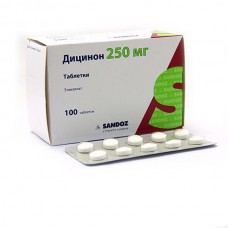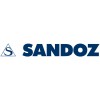Expiration date: 08/2026
Release form and composition:
Tablets white or almost white, round, lenticular.
1 tablet contains:
etamsylate 250 mg
Excipients: citric acid anhydrous, corn starch, povidone K25, magnesium stearate, lactose.
10 PCs. - blisters (10) - packs of cardboard.
The solution for the on/in and/m introduction colorless, transparent.
1 ml 1 ampoule contains:
etamsylate 125 mg 250 mg
Auxiliary substances: sodium disulfite, water d/and, sodium bicarbonate (used in some cases for correction of pH).
2 ml - ampoules (5) - blisters (2) - packs of cardboard.
2 ml - ampoules (5) - blisters (5) - packs of cardboard.
2 ml - ampoules (10) - blisters (2) - packs of cardboard.
2 ml - ampoules (10) - blisters (5) - packs of cardboard.
Pharmacological action:
Hemostatic drug. The drug increases the formation in the walls of capillaries mucopolysaccharides with high molecular weight and increases the resistance of capillaries, normalizes permeability in pathological processes, improves microcirculation. It has a hemostatic effect, due to activation of thromboplastin formation at the site of injury of small blood vessels. The drug stimulates the formation of coagulation factor III and stabilizes the adhesion of platelets. The drug does not affect prothrombin time, hypercoagulability has no properties and is not conducive to the formation of blood clots.
After the on/in the introduction of the drug takes effect within 5-15 minutes maximum effect is observed after 1 h, the duration of action is 4-6 h.
Pharmacokinetics:
Absorption and distribution
After I/V administration at a dose of 500 mg Cmax achieved after 10 minutes and equals 50 µg/ml.
After ingestion the drug is rapidly and almost completely absorbed. After taking the drug at a dose of 50 mg Cmax achieved through 4 h is 15 µg/ml.
Etamsylate crosses the placental barrier and is excreted in breast milk.
Excretion
About 72% of the administered dose is excreted via the kidneys during the first 24 h unchanged.
After the on/in the introduction of the T1/2 is about 2 h after ingestion T1/2 is about 8 hours.
Indications:
Prevention and treatment of capillary bleeding of different etiology:
- during and after surgical operations on all well-vascularized tissue in otorhinolaryngology, gynecology, obstetrics, urology, dentistry, ophthalmology and plastic surgery
- hematuria, metrorrhagia, primary menorrhagia, menorrhagia in women with intrauterine devices, epistaxis, bleeding gums
- diabetic microangiopathy (diabetic hemorrhagic retinopathy, recurrent hemorrhages into the retina, hemophthalmus)
- intracranial hemorrhage in neonates and premature infants.
Dosing regimen:
Pills
The optimal daily dose for adults is 10-20 mg/kg of body weight, divided into 3-4 reception. In most cases, a single dose of 250-500 mg 3-4 times/day. In exceptional cases the dose can be increased up to 750 mg 3-4 times/day.
When menorrhagia is prescribed 750-1000 mg/day, starting 5 days expected menstruation until the 5th day of the next menstrual cycle.
In the postoperative period the drug is administered at a dose of 250-500 mg every 6 h until the disappearance of the risk of development of bleeding.
Children appointed a daily dose of 10-15 mg/kg 3-4 reception.
The solution for/m and/in the injection
The optimal daily dose for adults is 10-20 mg/kg divided into 3-4 V/m or/in (slow) injection.
To adults during surgery prophylactically injected in/in or/m 250-500 mg 1 hour before surgery. During the operation/injected 250-500 mg, this dose can be repeated again. After the operation is administered 250-500 mg every 6 h until the disappearance of the risk of development of bleeding.
For children daily dose is 10-15 mg/kg of body weight divided into 3-4.
In neonatology: Dicynone is administered in the/m or/in (slowly) in the dose of 12.5 mg/kg (0.1 ml=12.5 mg). Treatment should begin within the first 2 h after birth.
The solution for/m and/in the injection can be applied topically: a sterile swab or gauze impregnated with the solution and applied to the wound (skin graft, tooth extraction).
If Dicynone is mixed with saline, it should be administered immediately.
Side effects:
CNS and peripheral nervous system: headache, dizziness, paresthesia of the lower extremities.
Dermatological reactions: hyperemia skin.
From the digestive system: nausea, heartburn, heaviness in the epigastric region.
Of the cardiovascular system: decrease in systolic blood pressure.
Contraindications:
- acute porphyria
- hematological malignancies in children (lymphoblastic and myeloblastic leukemia, osteosarcoma)
- thrombosis
- thromboembolism
- hypersensitivity to the drug and sodium sulfite.
With caution should designate product in thrombosis, thromboembolism history of bleeding on the background of an overdose of anticoagulants.
Pregnancy and lactation:
Application of pregnancy is possible only in cases where the potential benefits of therapy for the mother outweighs the potential risk to the fetus.
If necessary, the appointment of the drug during lactation breastfeeding should be discontinued.
Special instructions:
Before treatment should rule out other causes of bleeding.
1 tablet of Dicynone contains 60.5 mg of lactose (maximum daily dose of lactose should not exceed 5 g). It should appoint a drug to patients with congenital intolerance to glucose, a app lactase deficiency (lactase deficiency among some peoples of the North) or malabsorption syndrome of glucose-galactose.
The solution for/m and/in the introduction is only intended for use in hospitals and clinics.
Effects on ability to drive vehicles and management mechanisms
Does not require special precautions.
Overdose:
Data on overdose of the drug Did not provided.
Drug interactions:
Introduction in a dose of 10 mg/kg of body weight for 1 h before introduction of dextran prevents their antiplatelet effect. The introduction of Dicynone after the introduction of dextran exerts haemostatic action.
The combination of aminocaproic acid and menadione sodium bisulfite.
Pharmaceutical interaction
Farmatsevticeski incompatible (in one sprite) with other drugs.
Incompatible with sodium bicarbonate injection and sodium lactate.
Terms and conditions of storage:
The drug is in the form of a solution for/m and/in the introduction should be stored in a dark, inaccessible to children at temperature not exceeding 25°C. shelf Life – 5 years.
The drug is in tablet form should be stored away from light and moisture, inaccessible to children place at temperature not exceeding 25°C. shelf Life – 5 years.
When you see the staining solution for injection should not apply.


